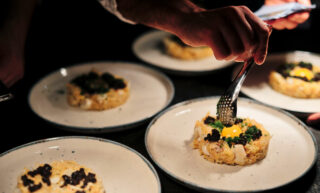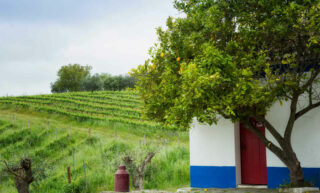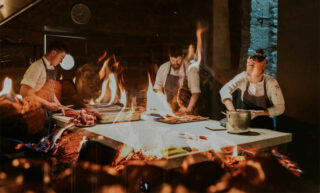Led by The New Douro wineries, the world’s oldest and arguably most beautiful demarcated wine area has built itself a reputation for warm and full-bodied red table wines. After almost a quarter century, winemaking is now reaching a new phase. While the climate is getting hotter and drier, the red wines are getting fresher and more elegant. The whites are simply world class.
From across a side valley you’d think Vinha da Torre (vinha is vineyard in Portuguese) would be blazing hot in the late morning sun. The rays of sunshine seem to bounce off the light brown dusty soil. But come closer and you realise that for most of the day the rays only skirt the vines and disappear behind the hill altogether long before the sun sets. “This vineyard is the hardest to work in the entire Douro Valley,” Jorge Moreira, winemaker and owner at Quinta da Poeira claims. When you stand on top of the vineyard and gaze down its vertiginous steepness you realise he might be right. Moreira pays his grape pickers a 30 percent premium – machines are out of the question with this inclination. But for Moreira this vineyard is the jewel in the crown of his estate. For its high altitude, its northern exposure and its 70-year-old bush vines he was willing to pay double the going rate. In an area where summer temperatures in the canopy now sometimes reach 50 degrees Celsius, his eagerness is understandable. But Vinha da Torre also demonstrates that winemaking in the valley of valleys isn’t cheap.
Vinha da Torre
More finesse – new developments don’t go unnoticed
The New Douro vintners, twenty-one in total, are a diverse group. From small quintas (Poeira is relatively small with only 11 hectare) to multi-quinta estates (Poças, for example, has three) and a sprawling association (Lavradores de Feitoria counts 600 hectare and 48 shareholders, of which 15 are growers), and from (still) predominantly port producing estates to a sparkling wine specialist (Vertice), what brings them together is their determination to make top quality table wines in the world’s best-known fortified wine region.
Port wines are typically made from concentrated grapes grown in the hotter parts of the appellation like the Pinhão Valley, where for instance Taylor’s (not a member) and Quinta do Noval have vast tracts of land. But demand for the sweet and alcohol-rich drink has been declining, and vintners had to look for an alternative, which they found in dry, unfortified table wine.
For a long time, the Douro Valley has been isolated and hard to reach, a place where people tend to stick to their traditions. So initially the table wines followed the same recipe as the Port wines. They were typically made from very ripe, concentrated grapes through a process of high extraction and blending. But with the wild Douro tamed by dams, and the towns now well connected by EU-funded roads, developments in the outside world don’t go unnoticed anymore. Hence an increasing number of vintners have jumped on the international bandwagon of leaner and fresher wines with more finesse.
Jorge Moreira
No Coca Cola
Jorge Moreira doesn’t come from a winegrowing family. Perhaps that is why he has been focusing on finesse and elegance right from the start. At the Primeira Prova, the annual tasting event of wines of The New Douro vintners in Peso da Régua, in the heart of the Douro Valley, Moreira shares with me his personal story. Although intellectually curious he didn’t fit into the traditional school system, but a love for the wine culture of the Douro Valley led him to enroll in the vinicultural college in Vila Real. Not having a family winery, it wasn’t easy to find employment after graduation. So he accepted a job as a salesperson of woodburning stoves in his brother-in-law’s business. But his father, who also loved wine and paid for his studies, was disappointed and encouraged him to do at least one vintage. Through a family friend he got the opportunity to do so at the Real Companhia Velha, where he worked alongside the American oenologist Jerry Luper, who effectively rekindled Moreira’s passion for wine. Luper’s ambition was to make French wines in Portugal – Cabernet Sauvignon & Co., Moreira recalls. His efforts were awarded with several prizes and as a stereotypical American person he wanted to repeat that success. But, Moreira says, wine making isn’t like making Coca Cola. There is no recipe – every vintage is different. So they grew apart, and Moreira bought his first vineyard that evolved into what is now Poeira, located on a north-facing slope in the Pinhão Valley.
Here he grows predominantly indigenous varieties: Touriga Franca, Touriga Nacional, and Sousão. For his white wines he uses Alvarinho, which, although native to Northern Portugal, makes only rare appearances in the Douro Valley, but Moreira finds it a complete variety with great ability to express its terroir. And indeed his Poeira Branco 2020 is an excellent wine. Its relatively high phenolic content is softened through micro-oxidation in used barrels rendering it fresh and round, with notes of green and yellow apples, lemon, wafts of fresh air-dried laundry and nutty overtones.
Cooler sites for excellent whites
In parallel with the trend to shift to north-facing slopes, vineyards at higher altitude have become in higher demand too. Almost all the vintners I spoke to stressed the importance of these cooler sites, which are the source of often fantastic, delicate white wines, for instance Wine & Soul’s Guru Branco. Made from Rabigato, Viosinho, Côdega de Larinho and Gouveio – all except for the last are native to Northern Portugal; Gouveio comes from adjacent Galicia, where it is called Godello – this wine is flinty, mineral, ripe with a distant vegetal echo, and fresh (thanks to Rabigato and Gouveio, less so from the other two). The use of French oak (mostly used) for fermentation and seven months of maturation provided subtle hints of vanilla and clove. Bâtonnage rounded out the profile.
Poças' Cellars
Also Poças makes a wonderful white wine, from Códega (or Síria) and Arinto. Fermented and aged in new French 300-liter casks, this is a more full-bodied wine than the Guru Branco, but nonetheless – due the vineyard’s altitude (600m) and soil (granite and schist) – zesty and mineral with spicy notes and bottle-aging potential.
Tapping from Portugals wide range of indigenous varieties
As for the reds, less extraction, cooler sites and earlier harvest dates are just three of the tools vintners like Moreira have to make fresher wines. They also look at the enormous collection of indigenous Portuguese varieties. Sousão, for instance, a colour-intense and high-acidity variety is on the rise. Moreira uses it in its blends, and Tiago Alves de Sousa makes a delicious monovarietal wine from it. For Real Companhia Velha, which he rejoined as a consultant, Moreira focuses on an array of alternative varieties (Malvasia Preta, Cornifesto, Rufete, Baga, Tinto Cão) to create more elegant wines while at the same time dealing with the effects of climate change.
Also Francisco Olazabal of Quinta do Vale Meão sees Baga as a promising, high acidity variety. His delicious Monte Meão Vinha da Cantina 2019 is medium-bodied and savoury punctuated by notes of coffee and nutty sesame on a frame of fresh, dark cherries and fine-boned tannins – perhaps not as vibrant as its brethren from Bairrada (Baga’s cooler Atlantic home region), but hugely rewarding nonetheless.
Another variety that is gaining ground is Tinto Cão. Officially one of Port wine’s five main varieties, it has always had a bit of a bad reputation for being hard to ripen. But with increasing heat this may change. Moreira, among others, sees potential when you take it off the skins early to avoid the overextraction of woody tannins.
Tiago Alves de Sousa
Bottom up approach
While a shift to fresher and leaner wines seems to be gaining momentum, the move to terroir-driven wines is less prominent. Wine & Soul’s Jorge Serôdio Borges’s deepest wish is to establish a vineyard-based system, but over dinner at DOC, Rui Paula’s restaurant in between Pinhão and Peso da Régua, he says he has given up hope the IVDP, the regulating body for Douro and Port wines, is going to take the lead. A bottom-up approach, he thinks, may be slower, but probably more effective. To practice what he preaches, his top lines, Manoella and Pintas, are effectively single vineyard wines. The Manoella Vinhas Velhas 2019 in particular was one of the highlights of the three-day Primeira Prova tasting: plenty of powdery tannins, great concentration, well-integrated alcohol and freshness are the base for intense floral notes, red and dark cherries, some tar and graphite, and subdued spices – a near perfect compromise between warm-blooded concentration and slender elegance.
In comparison, Poeira’s Vinha da Torre, from more than 70-year-old vines in Moreira’s most precious, eponymous vineyard, felt a fraction fresher (I didn’t taste them side by side) with a more sinewy elegance, exemplifying the shift to leaner wines a bit better than the Manoella. On the other hand, the Manoella proved that grapes from warmer sites (the vineyard is southwest facing) can, in the right hands, be enormously satisfying. Some would even argue that a full body and warmth are essential characteristics of the Douro Valley’s terroir.
Ultimately, the Douro Valley, with 43,000 hectare a large appellation that stretches out from east to west over about 100 kilometers, inevitably offers a myriad of terroirs. Serôdio Borges’s suggested first step on the way to more terroir focus would be to split up the region in different appellations. Whether that should be done using the current division into three subregions (Baixo Corgo, Cima Corgo and Douro Superior) that become hotter and drier traveling east, or based on altitude, as for example in Burgundy (Côte de Nuits vs Hautes-Côtes de Nuits), can be part of an interesting discussion.
Some other remarkable wines not mentioned above.
WHITES
Alves de Sousa
Branco da Gaivosa Grande Reserva 2020, 12.5% abv
From Códega do Larinho, Rabigato, Viosinho.
Complex nose with a bit of petrol and chalk.
Round mouthfeel, just enough acidity, medium bodied. Restrained fruit, some clove, mineral.
Niepoort
Redoma Branco 2020, 12% abv
From Rabigato, Códega, Viosinho, Donzelinho, Dorinto and other varieties
Lemony, stony nose, hint of white almond, fresh herbs.
On the palate creamy brioche notes, a bit vegetal, nutty, stony, nice texture, medium bodied. What it may lack in concentration is compensated by complexity. Good value.
Poças
Branco da Ribeira 2020, 13,5% abv
Made from Arinto, Códega.
Spicy and smoky on the nose followed by stony minerality and restrained, mostly citrusy fruit.
On the palate dry, spicy, fresh, round mouthfeel with simultaneously a fine chalky texture. Medium body, lean and elegant. Good length.
Quinta Vale D. Maria
Vinhas do Sabor White 2021
Single vineyard wine.
Spicy nose with slightly reductive nutty sesame overtones.
On the palate light spices layered with citrus and toasted sesame, medium body, fresh acidity and creamy mouthfeel. Good value.
Van Zellers & Co
CV Branco 2015, 13,5% abv
Cristiano van Zeller’s pursuit is to make an ageable white wine without emulating Burgundy. With seven years, this white from the free run juice of a field blend of old vine Rabigato, Samarrinho, Donzelinho Branco, Viosinho, Códega and others showed ripe white and yellow fruit and interesting oxidative notes from bottle ageing, layered over a good acidic backbone.
REDS
Niepoort
Voyeur 2020, 11.5% abv
Field blend of old vines from six different parcels fermented individually in clay amphorae.
Looks like a slightly dark rose.
First sniff reveals beautiful yellow-red cherries and a faint smell of roses followed by a waft of earthiness.
Light body, fresh acidity, and low tannins but nonetheless some grip.
Not everyone’s cup of tea, but I loved it.
Poças
Fora da Série Roga 2020, 12% abv
Roga is the Portuguese word for the group of people who harvest the grapes. In the olden days, the grape pickers received housing, food and drink as part of their remuneration. This wine was inspired by the traditional drink of the roga made of the mash diluted with water, thirst-quenching and less inebriating.
Short maceration, after which the stems of white grapes were added for additional freshness.
Simple cherry flavours, some stony minerality, light-bodied, refreshing acidity and light tannic grip.
Drink slightly chilled.
Poças
Reserva Tinto 2019, 13.5% abv
From four of the traditional Douro varieties: Touriga Nacional, Touriga Franca, Tinta Barroca, Tinta Roriz.
Medium ruby with bluish reflections. On the nose there are red and dark berries, a hint of forest leaves, a bit of tar. On the palate it is soft but well structured with powdery tannins and generous acidity. Restrained fruit, hints of rosehip and lily, stony minerality, subtle spicy oak. Still young.
Alves de Sousa
Abandonado 2019, 14.5%
Single vineyard with over 85-year-old vines of more than 25 indigenous varieties.
From a remote, high altitude, stony vineyard surrounded by woods with many empty patches that was almost given up (hence Abandonado), but oenologist Tiago Alves de Sousa gave it a last chance. Fortunately!
On the nose restrained, minerally, pure, some prunes and a waft of benzine.
Lots of powdery tannins, but very elegant and long.
Quinta da Romaneira
Reserva 2019, 13.5%
All Quinta da Romaneira’s wines stood out for their elegance and nimbleness.
Fragrant, dark and red berries, some cedar, a vegetal note, some tar, stony.
In the mouth spicy notes, followed by a hint of tar, then fruity freshness, some subtle sweet vanilla and violets. Long finish.
Quinta do Vale Meão
Monte Meão Cabeço Vermelho 2019, 14% abv
Made of 100 percent Tinta Roriz (Tempranillo)
On the nose fresh red fruit with a bit of tar.
Generous amount of powdery tannins, invigorating acidity, medium body, fresh red fruit.
Casa Ferreirinha
Castas Escondidas 2019, 13.5% abv
From old vines: Tinta Amarela, Touriga Fêmea, Tinta Francisca, Tinto Cão, Touriga Nacional, Touriga Franca, Marufo Tinto, Bastardo. For this wine Casa Ferreirinha works with growers to encourage them to keep on cultivating old indigenous varieties.
A bit restrained on the nose, some red and dark cherries, some tar, hint of violets.
Fine-boned tannins, rather complex dark and red fruit with some dried fruit and a floral note, good concentration, fresh acidity. Drinkable now, but will get better.
A version of this article (in Norwegian) has been published in Apéritif (issue 4 2022)






Comments